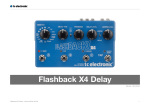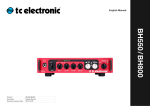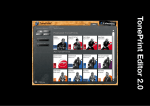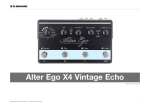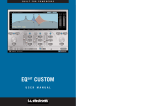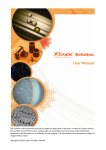Download USER`S MANUAL
Transcript
USER’S MANUAL Important Safety Instructions 1 2 3 4 5 6 7 Read these instructions. Keep these instructions. Heed all warnings. Follow all instructions. Do not use this apparatus near water. Clean only with dry cloth. Do not block any ventilation openings. Install in accordance with the manufacturer’s instructions. 8 Do not install near heat sources such as radiators, heat registers, stoves, or other apparatus (including amplifiers) that produce heat. 9 Only use attachments/accessories specified by the manufacturer. 10Refer all servicing to qualified service personnel. Servicing is required when the apparatus has been damaged in any way, such as power-supply cord or plug is damaged, liquid has been spilled or objects have fallen into the apparatus, the apparatus has been exposed to rain or moisture, does not operate normally, or has been dropped. Warning! • To reduce the risk of fire or electrical shock, do not expose this equipment to dripping or splashing and ensure that no objects filled with liquids, such as vases, are placed on the equipment. • Do not install in a confined space. Service • All service must be performed by qualified personnel. Caution: You are cautioned that any change or modifications not expressly approved in this manual could void your authority to operate this equipment. When replacing the battery follow the instructions on battery handling in this manual carefully. EMC/EMI This equipment has been tested and found to comply with the limits for a Class B Digital device, pursuant to part 15 of the FCC rules. 2 These limits are designed to provide reasonable protection against harmful interference in residential installations. This equipment generates, uses and can radiate radio frequency energy and – if not installed and used in accordance with the instructions – may cause harmful interference to radio communications. However, there is no guarantee that interference will not occur in a particular installation. If this equipment does cause harmful interference to radio or television reception – which can be determined by turning the equipment off and on –, the user is encouraged to try correcting the interference by one or more of the following measures: • • • • Reorient or relocate the receiving antenna. Increase the separation between the equipment and the receiver. Connect the equipment to an outlet on a circuit different from the one to which the receiver is connected. Consult the dealer or an experienced radio/TV technician for help. For the customers in Canada: This Class B digital apparatus complies with Canadian ICES-003. Cet appareil numérique de la classe B est conforme à la norme NMB-003 du Canada. 3 (EN) Introduction Congratulations! You have just bought a reverb pedal that is a steppingstone to a world of inspiration, innovation and tone. We are proud to present Hall Of Fame Reverb. In the music industry, TC Electronic is synonymous with the best reverb out there – a reverb that you know from countless songs and classic albums, but that’s not all. We love tone as much as any guitarist out there, so we are very excited to present a brand new, groundbreaking concept: TonePrint! TonePrint gives instant access to custom-tweaked sounds. We have gathered an impressive list of guitar heroes and had them tailor their signature sounds – the tones that made them famous. TonePrint will not just bring you close to the sounds of your idols, they give you their actual sounds! Using TonePrints is both easy and fun. Just download the TonePrint you want from www.tcelectronic. com and, voila, your favorite artist has just put a TonePrint in your pedal. Forget emulation – let’s talk collaboration! www.tcelectronic.com - www.youtube.com/tcelectronic 4 1 - Effect on/off (true bypass) 2 - 1/4 inch mono jack input 3 - 1/4 inch mono jack input (for stereo in) 4 - 1/4 inch mono jack output 5 - 1/4 inch mono jack output (for stereo out) 6 - FX level control 7 - Decay time control 8 - Pre Delay short/long 9 - Tone control 10 -Reverb type selector 11 -Power in (9VDC) 12 -USB connection for exchanging TonePrint settings and software updates. 5 Connecting Input jacks - Use MONO for mono input and both MONO and STEREO if connecting a stereo source. If you run the pedal on battery we recommend removing the mono jack to preserve battery power when you don’t play. Output jacks - connect to another pedal or directly into an amp or mixer. Use MONO for mono setups and both MONO and STEREO for stereo setups. Notice that it is possible to select between true bypass and buffered bypass mode via a dip switch located under the battery cover. Power in - use a 9 VDC power supply with the following symbol: USB Connect to a computer using the supplied USB cable for upload of TonePrint settings. The connector-type is Mini-B. 6 The controls FX LEVEL Controls the level of the reverb. Notice that the level of the direct signal is always passed at the original level (unity gain). Only the level of the reverb is changed when turning the FX level knob. DECAY The Decay knob sets the decay time of the reverb. Please note that the max. decay time on the different reverb types varies due to the nature to the reverbs. TONE By adjusting the tone you change the emphasis on high and low frequencies in the reverb from dark to crisp. The “best” setting is really a matter of how dominant you wish the reverb to sound. PRE DELAY Pre-delay is the time between the direct sound and the reverb. To keep the direct sound “in-your-face”, even with a long decay time and a high mix setting, try the long pre-delay setting. REVERB TYPE selector The Reverb Type selector allows you to select between the types described in the following section. 7 Reverb Types The reverb naturally found in various types of rooms depends on many different factors: The size of the room, the material the walls are made of (wood, stone etc.), is the room furnished or not, how high is the ceiling, is it a church, etc. ROOM The Room algorithm simulates a relatively small, well furnished room. In such a room, many reflections are absorbed by soft materials, and the sound is reflected and sustained only by the walls (covered with wallpaper), windows and maybe some furniture. HALL The Hall Acoustic preset is a broad yet slightly diffuse reverb. It simulates a large environment but adds a distinctive acoustic flavor to the source material. Great discreet reverb for large epic sounds at longer decay settings but also perfect for genuine ambient sounds at shorter decay settings. SPRING The Spring algorithm has been designed to reproduce the sound of the old spring reverbs, such as the ones used in vintage guitar amps. 8 PLATE Prior to the digital era, reverb was created either using springs or large metallic plates. A Plate reverb is recognized by its very diffuse and bright sound and is excellent for guitar when you search for a significant guitar reverb. CHURCH A highly diffuse large reverb that is recognizable for its emulation of the many hard surfaces of different shapes found in traditional church rooms. If you are looking for a large reverb and think the Hall is too clean and subtle – try Church. MOD - Modulated The MOD mode adds modulation to the reverb only - not to the dry signal. This opts for a reverb that is really noticeable and cuts through in live situations. LOFI Down and dirty reverb. Use LOFI and show your awareness of aiming in the straight opposite direction of a smooth discrete studio reverb type. Make a statement. 9 TILE If you want the “bathroom” effect, without actually sounding like you’re playing in your bathroom. The Tiled Room reverb simulates the qualities of a small to medium size tiled room with its many reflections and at the same time it behaves respectfully towards the original source material. This is not a soft smooth reverb - this one cuts through the mix. AMB (AMBIENCE) Ambience is a cool very short reverb that emulates the feeling of environment. Perfect to compensate for that desert-dry feeling of a close-miked cabinet. GATE The classic reverb type typically heard on snare and kick drums on many 80s recordings. A gate is used to rather abruptly shorten the reverb decay. Try it out and allow yourself to stand out from the common usage of reverbs on guitar. 10 TonePrint Think of the knobs and switches on your pedal as a few handles that actually control a large number of parameters. TC Electronic staff has defined the controls, - but wouldn’t it just be cool to let the world’s leading guitar players contribute their own definition of how the controls should work? YES - this is TonePrint. We allow top guitar players to dig out the pedal’s hidden tonal potential, re-define the controls and make their own TonePrints. These TonePrints are available for you online, and uploading TonePrints to your pedal is easy. • • • Connect the pedal to your Mac or PC computer using the supplied USB cable. Find your pedal at www.tcelectronic.com/pedals and download the TonePrint setting from your favorite guitar player to a location where you can easily locate it again – e.g. your desktop. Open the application and press UPDATE. Now, – once you have selected TonePrint, all controls react exactly as defined by the artist that has provided the TonePrint. 11 Bypass modes and Kill Dry on/off Unscrew the back-plate and look for the two small dip-switches in the upper left corner. The upper dip-switch (closest to the DC 9V in connection), switches between True Bypass mode (default) and Buffered Bypass mode. True Bypass Buffered Bypass Kill-Dry - off Kill-Dry - on True Bypass – is a hard-wire bypass that gives absolutely no coloration of tone when the pedal is bypassed. Using True Bypass on all pedals is a perfect choice in setups with a few pedals and relatively short cables before and after the pedals. 12 Buffered Bypass – If you use a long cable between your guitar and the first pedal or if you use many pedals on your board or if you use a long cable from your board to the amp, then the best solution will most likely be to activate the buffer in the first and last pedal in the signal chain. Can you hear the difference between a pedal in True Bypass or Buffered Bypass mode? Maybe, maybe not, – many factors apply. Active/passive pick-ups, single coil/humbucker, cable quality, amp impedance and more. We cannot give a single ultimate answer. Use your ears and find the best solution for your setup! Kill-Dry on/off – With Buffered Bypass activated (upper switch to the right), the lower dip-switch sets Kill-Dry on/off. Kill-Dry removes all direct signal from the pedals output and is the mode to use when the pedal is placed in a parallel effects loop. Kill-Dry is NOT an option in True Bypass mode. Changing battery – Unscrew the thumb-screw on the back of the pedal and detach the back-plate. Unmount the old battery and attach the new battery to the battery clip making sure the polarity is correct. Then remount the back-plate. To save battery life, remove the input jack when you don’t play. Batteries must never be heated, taken apart or thrown into fire or water. Only rechargeable batteries can be recharged. Remove the battery when the pedal is not being used for a longer period of time. Dispose batteries according to local laws and regulations. 13 Sounds 10 renowned TC Electronic reverb effects including the legendary TC Classic Hall and stunningly realistic plate and spring reverbs Unique, new TonePrint setting for stuffing Hall of Fame with your favorite artist’s tones Size & Weight 72 mm x 122 mm x 50 mm - 300 g (excl. battery) Battery Dual Supply Rails technology ensures headroom for line level effect loops from a single 9V battery. Battery failure circuit automatically puts Hall of Fame into true bypass mode if the battery runs out Design Custom ‘hammerhead’ rugged, die-cast aluminum casing built for a life on the road Unique one-screw battery access for lightning fast battery changes Connectors & Inputs/Outputs Stereo inputs with automatic mono/stereo sensing – feed it any signal Stereo outputs for that ultra-wide reverb sound Mini USB connector for uploading custom TonePrints and software updates Knobs etc Decay, Tone, FX Level and Reverb Mode knobs with high-quality, metal-shaft potentiometers Heavy duty tactile footswitch with true bypass for zero tone coloration In the box USB cable for uploading TonePrints, Owner’s Manual, TC Electronic Guitar Pamphlet, TC Electronic Sticker. These specifications are subject to change without notice (EN) Technical Specifications 14 TC Electronic, Sindalsvej 34, DK-8240 Risskov [email protected]



















